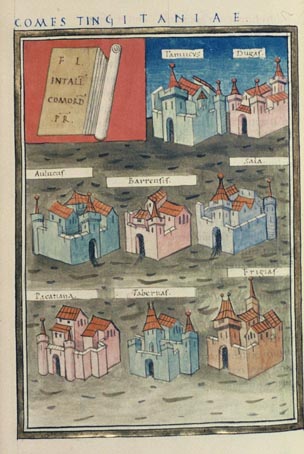
This page last modified: 3 January 2015 (Sala interpolation commentary updated)

 Above: Frontpiece from the Bodleian manuscript (O). The stations depicted are: Tamucus, Dugas, Aulucus, Bariensis, Sala, Pacatiana, Tabernas, Frigias. |
The following commanders of Limitanei units are listed as being at the disposal of the Count of Tingitania (i.e. northern Morocco; the numbers beside the names refer to Ingo Maier's numbering scheme):
130.3 Praefectus alae Herculeae, at TamucoIn addition, the following infantry units are listed as being under the command of the Count of Tingitania, drawn from the Magister Peditum's Infantry roster: 102/5.188 Mauri tonantes seniores (an auxilia palatina unit)along with the following cavalry units, drawn from the Magister Equitum's cavalry roster: 102/5.258 Equites scutarii seniores comitatenses (i.e. Equites scutarii, a vexillationes comitatenses) |
Note that Seeck in his 1876 edition added an entry (OC.XXVI.17) between 130.6 (Tribunus cohortis primae Ityraeorum) and 130.7 (Tribunus cohortis Pacatianensis) for a tribune of an unknown cohort based at Sala, since such a location is shown in the frontspiece (see the illustration above); he also bracketed the descriptor comitatenses after each cavalry unit as something to be deleted; why he did this is unknown... He also amended (OC.XXVI.19) the "Hastorum" in Tribunus cohortis tertiae Hastorum to "Asturum".
A unit of Septimani iuniores is also listed as being present in both the Italian and Gallic field armies; the Gallic one however is pseudocomitatenses, and is thus likely to be the Septimani listed as pseudocomitatenses in the Magister Peditum's infantry roster. More problematic is that there is a Septimani iuniores also assigned to the Magister Peditum's Italian command. Likewise, a Constantiniani is also listed under the Comes Africae; as is an Equites scutarii. Given these overlaps with the forces listed under the Comes Africae (which also has overlaps with the forces listed under the Dux et praeses provinciae Mauritaniae et Caesariensis and the Dux Tripolitanae), it seems that these identically-named African units would appear to be listings of same unit separated by time as well as (or perhaps instead of) space.
The shield patterns of the non-limitanei units are shown below as depicted in various manuscripts, except that of the Equites sagittarii seniores, as its pattern is absent from the Notitia:

Those beside O come from the Bodleian manuscript in Oxford, those beside P from the Paris manuscript, those beside M from the first portion of the Munich manuscript, those beside W from the second portion of the Munich manuscript, those beside B from the Froben edition, and those beside Ff from the Frankfurt fragment.
Note that B swaps the patterns for the Mauri tonantes seniores and the Mauri tonantes iuniores; I have restored them to their "correct" order.
Inscriptional evidence (CIL 8,8440) shows a detachment of two cohorts from Legio II Herculiae, normally under the command of the far-away Dux Scythiae, were operating in Sitifis (modern Setif in Algeria) in 298/289 under the emperor Maximianus Herculius; it may be that the same legion also provided a cavalry component that stayed behind and became the Ala Herculea of the Comes Tingitaniae.

Return to the Notitia index page.